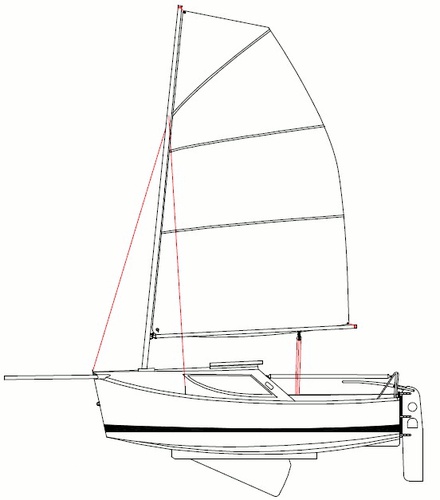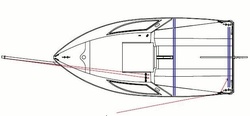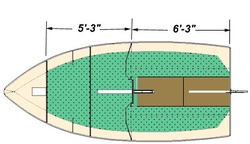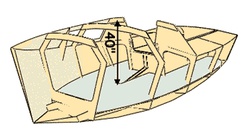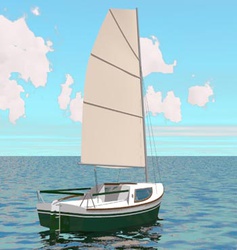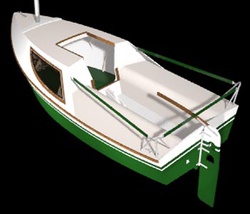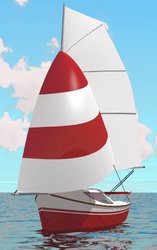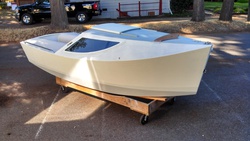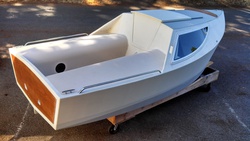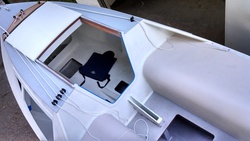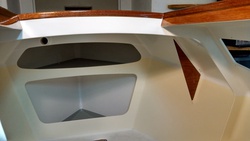Adelie 14 by Bateau.com
[AD14] A mini cruiser for coastal cruising and occasional short offshore passages
| Length overall | ||
|---|---|---|
| Beam | ||
| Draft | ||
| Draft (cb up) | ||
| Berths | 4 | |
| Weight | ||
| Ballast weight | ||
| Sail area | ||
| Hull construction | Stich-n-glue | |
| Gallery | 7 photos | |
| See also | Adelie 16 | |
| compare | ||
URL: http://www.bateau.com/proddetail.php?prod=AD14
Description:
Adelie is a very small but very able coastal cruiser.
Some may ask what makes one 14' boat "ocean capable" and the other one a coastal cruiser or a day boat for protected waters? Besides some obvious features like ballast, scantlings and size of openings, it is the skipper that makes a boat offshore capable or not.
Here is what Dudley Dix said about it in an interview to SmallCraftAdvisor: "I come to the conclusion that there is one major factor which contributes to the ability of the boat to deal with extreme weather. That is the need for an experienced, levelheaded and capable skipper, with a thorough knowledge of the abilities and limitations of his own boat. Such a skipper will bring his vessel and crew through almost anything. In contrast, even the most seaworthy of boats may be at risk in moderate weather without a competent skipper."
While it was not our goal our goal to design an offshore boat, Adelie will compare favorably with boats designed for offshore use or labeled as such.
As designed and with a good skipper Adelie can make short offshore crossings like safely sail to the Bahamas or cross the British Channel. With some minor modifications, she could do much more.
Adelie has a vee-hull with a small keel shoe and a ballasted CB keel that can be locked in two positions. The 250 lbs ballast is located half in the CB keel and half inside.
She is virtually uncapsizable. Thanks to her high sides, full width cambered deck and 250 lbs. of ballast; she has a positive righting arm up to 135 degrees. Fill the mast with foam and it gets even better.
In the very unlikely case of a full roll over, she will recover very fast: her high profile cambered deck makes her very unstable upside down.
Those comments about capsizing and stability should not frighten inexperienced sailors. Extreme heel angles are very rare and will never happen under normal sailing conditions but we prefer to anticipate that typical question.
Handling Adelie under sail is easy: the fully battened sail makes her easy to reef, a must for serious cruising.
All lines and even the anchor can be handled from the companionway, no need to go on deck.
The self-bailing cockpit is well above the waterline and separated from the cabin by a lower bulkhead acting as bridge deck.
Sturdy lifelines surround the cockpit: wide straps that support the back of the crew. Better, the boat can be made unsinkable with the addition of buoyancy foam and if you build the foam sandwich version, very little additional foam is required.
The cockpit is roomy and deep with comfortable seats. The cockpit sole is sloped towards the stern for drainage. The cockpit bulkhead forms a bridge deck that keeps the cabin dry.
To keep things simple, we do not show a main sheet traveler but one can be added. The sheet goes to a fiddle block with cam cleat at the end of the CB trunk well. The CB keel is lowered and raised from the cockpit. A small part of the trunk well extends above the cockpit sole and makes a perfect footrest when the boat heels.
The cabin side extensions (wings) are cut to act as a grab bar.
A drop panel in two parts and a removable hatch closes the companionway. The upper part of the drop panel can be left out to provide ventilation when sleeping aboard.
With the hatch open, the crew can reach all control lines.
Note the lightening holes in the rudder. They are shaped as foot steps: the rudder makes double use as a boarding ladder.
Down in the cabin, the KISS principle prevailed: simple but comfortable camping style accommodations. To put more in such a small space may look good on paper but is not realistic or practical.
A wide but low cabin sole gives between 36 and 42" sitting headroom inside. Wet storage for anchors lines etc. is provided forward of the mast bulkhead and separated from the sleeping area by a 6" high board. There is easy access to the mast step and optional spinnaker pole.
We show some hatches in the sole, one for access to the CB keel pivot pin. There are several cubic feet available under the sole for fresh water and other stores and there is room under the cockpit to store an outboard. The sole extends under the cockpit seats. Even there, there is enough room sleep and turn around.
Clothes and books can be stored in nets hanging along the sides.
Boat hook, emergency paddle and fishing rods will hang from the ceiling.
The builder is free to customize the interior with shelves, a small galley that slides under a cockpit seat or a shelf across the beam and against the cockpit bulkhead. That shelf could altogether be a step and a small table.
The open layout provides enough room to sleep 4 adults but it would be cramped. Two adults with frugal requirements will be comfortable during long cruises, maybe 2 adults and 2 small children for short cruises.
We may not show a vent on the cabin but if you choose to install the optional retractable pole, the openings will provide sufficient draft to keep the boat dry. Otherwise, a small deck vent will do the job.
Photo gallery
See also
Boats about same size as Adelie 14
|
|
Tread Lightly
The littlest practical cabin cruising yacht
|

|
PocketShip
15-foot Fast-Sailing Pocket Cruiser with Sitting Headroom and 8-foot Berths
|
Questions? Suggestions? Contact us at: info@boatplans.cc
